Inside you, there aren't two wolves
What progress, you ask? Find out about fakelore, activity tracking, and more.
Hi, Cynics! I hope you don’t mind if I call you that, because I’m going to anyway.
I think we could all use a break from ultrapersonal infodumps, so I’m going a bit lighter for this newsletter. It’s partly out of necessity. My little lad had a fever last night (don’t worry, he’s OK!) and his mum and I are pretty damn sleep deprived. As a result, I spent a good chunk of today with a sniffly toddler lying on me wondering what I was actually going to write. I have a bunch of pretty solid stuff lined up, including an interview with a neuroscientist and a wanking expert,1 but due to circumstances it’s not coming out today.
My wife — who I’m going to start calling Louise for in these newsletters because a.) that’s her name and b.) calling her “my wife” all the time made me hear Borat in my head — reminded me of that progress graph meme you’ve probably seen. If you haven’t, or need reminding, it looks like this:
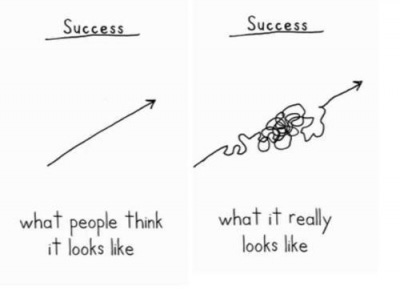
I tried to find the creator of this illustration so I could attribute it to them, but it seems like it’s just one of those cliches that’s been done a million times, eventually making the leap to LinkedIn hustlebro clickbait. Which makes me want to dislike it, but just because boring people use it in their posts to bait algorithmic engagement doesn’t make it any less helpful. Although it’s reductive and banal to reduce human experience to a trendline, life does take a lot of twists and turns, and as I’ve written before, your baseline for progress shifts as you start doing better. So there’s enough truth in it for me to take comfort in it, and be comfortable passing it on.
It does make me want to write about other popular cliches, and what some of the problems with them might be.
You might have seen this one before:
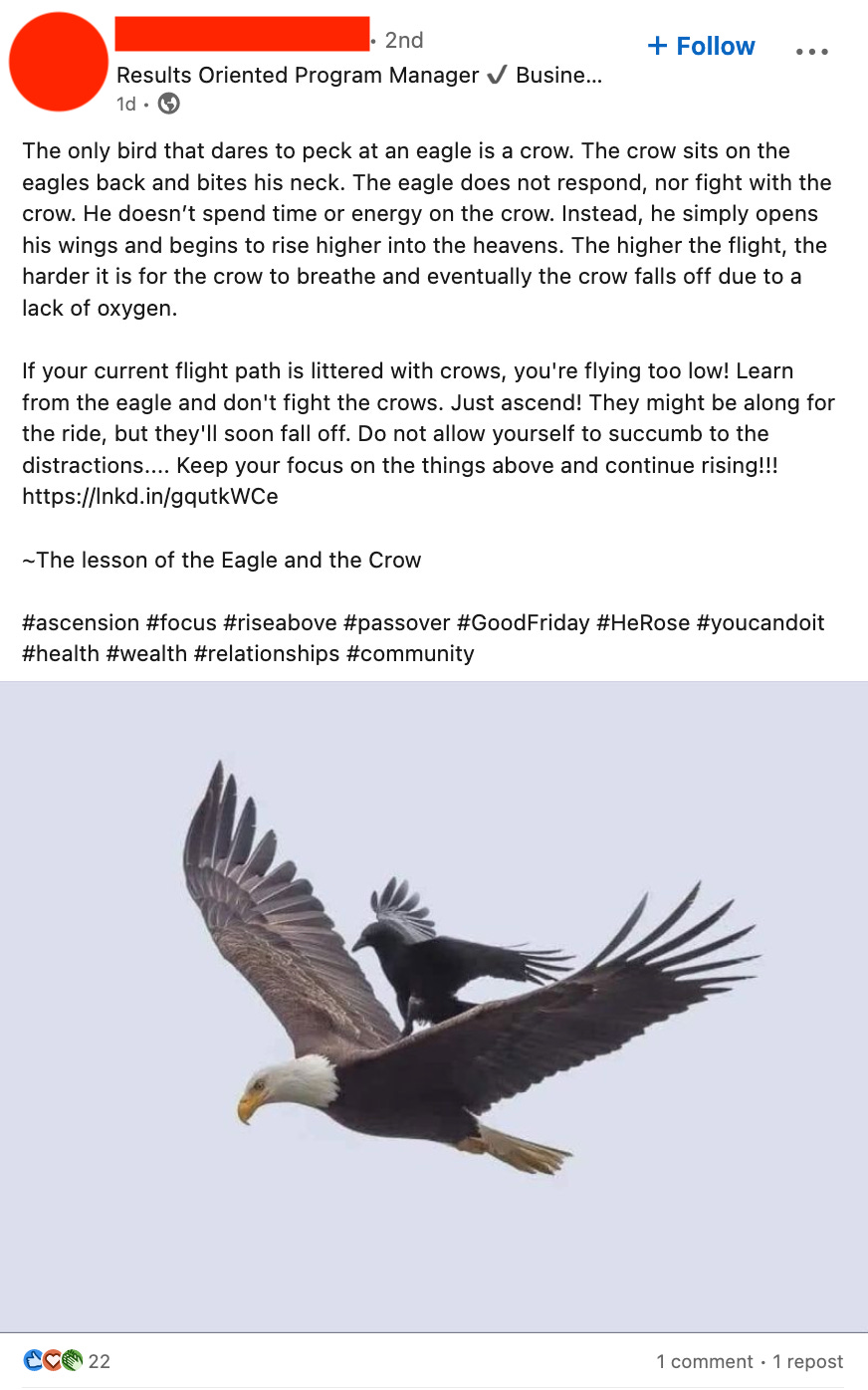
The issue with this, as with so much stuff on LinkedIn and other social networks, is that it’s bullshit. I am a bit of a bird nerd, so this one really rankles. While the picture is real (it was taken by Phoo Chan, a Californian photographer) crows are not “the only bird that dares peck at an eagle.” Many self-respecting bird species will have a go at an eagle if one shows up, for extremely obvious reasons. When I was a kid, we had a pet magpie for a few years, and it used to attack hawks all the time. We’d go outside and watch the show. What’s more, the thing about “eventually the crow falls off due to a lack of oxygen” is just tripe. Eagles can fly damn high but the crow isn’t going to risk hanging around on the eagle’s back for long enough to asphyxiate.
Maybe I’m taking it too seriously, but I find it hard to take inspiration from bullshit. It’s not just that someone took it upon themselves to write up a bunch of easily-debunked lies about crows and eagles, but that people accept it so passively, while making the effort to spread it so eagerly. My only hope is that the meme has led people to do some Googling and find out not only that it’s bullshit but how awesome crows actually are.
Here’s another one you definitely know:
An old Cherokee is teaching his grandson about life. “A fight is going on inside me,” he said to the boy.
“It is a terrible fight and it is between two wolves. One is evil – he is anger, envy, sorrow, regret, greed, arrogance, self-pity, guilt, resentment, inferiority, lies, false pride, superiority, and ego.” He continued, “The other is good – he is joy, peace, love, hope, serenity, humility, kindness, benevolence, empathy, generosity, truth, compassion, and faith. The same fight is going on inside you – and inside every other person, too.”
The grandson thought about it for a minute and then asked his grandfather, “Which wolf will win?”
The old Cherokee simply replied, “The one you feed.”
Seems kind of profound, doesn’t it? It seems self-evident that if you give the worse aspects of your nature all your energy, they’ll come out on top. And I know for sure that you’ve seen the story before because it’s in damn near every email forward from Grandma and inspirational meme and panel-van-tier artwork and self-help book ever written.

Too good to be true? Of course. Scratch the surface and you’ll find pure, unadulterated bullshit. And not just ornithologically-inaccurate bullshit, but culturally-destructive colonialist bullshit. As the Métis academic Chelsea Vowel pointed out more than a decade ago on her blog, âpihtawikosisân, the story has nothing to do with any Indigenous American culture. It seems, almost inevitably, to have originated with Christian Evangelical preachers, perhaps Billy Graham himself.
There’s a term for made-up popular wisdom that’s propagated and reposted endlessly: fakelore. And while I think the sentiment of the story is harmless and even inspiring enough — it has clearly resonated with enough people to inspire millions of posts and hundreds of thousands of bad wolf Photoshop jobs — the effect it has on Indigenous culture is anything but helpful. Here is Vowel what fakelore can do:
The replacement of real indigenous stories with Christian-influenced, western moral tales is colonialism, no matter how you dress it up in feathers and moccasins. It silences the real voices of native peoples by presenting listeners and readers with something safe and familiar. And because of the wider access non-natives have to sources of media, these kinds of fake stories are literally drowning us out.
I don’t think there’s anything wrong with the metaphor of two wolves, but clearly, falsely attributing it to Native Americans is a problem. And if it somehow seems less resonant when you attribute it to Christian preachers rather than an imaginary wise tribal elder, that might be worth reflecting on.
So, if fake internal wolves and hypothetical crow-asphyxiating eagles aren’t good inspiration, what is?
Well, when I was Googling around for that success graph, with a phrase along the lines of “this is what progress looks like,” I found something rather lovely.
Because this is a self-improvement blog and you’re reading it, you have very likely heard of Seneca, the famous Roman Stoic from the time of Nero. If you don’t yet know of Seneca, it seems he was a decent dude (at least by the crucifixion-happy standards of Ancient Rome,) and he has the added advantage of the passage of time rendering him uncancellable. While I’ve yet to read much of his stuff, I get a kick out of the fact that his surviving writings originated as a kind of ancient equivalent to this blog: finding the good shit in the vast wastes of contemporary self-improvement scrolls and passing it on. Here he is writing to his mate Lucilius:
I shall therefore send to you the actual books; and in order that you may not waste time in searching here and there for profitable topics, I shall mark certain passages, so that you can turn at once to those which I approve and admire.
At the time of writing (somewhere around 65 CE) Seneca was exercising his highlighter on the writings of a Greek Stoic called Hecato. His stuff is mostly lost to history, but thanks to Seneca and others, we have snippets:
Meanwhile, I owe you my little daily contribution; you shall be told what pleased me to-day in the writings of Hecato; it is these words: "What progress, you ask, have I made? I have begun to be a friend to myself." That was indeed a great benefit; such a person can never be alone. You may be sure that such a man is a friend to all mankind.
Now that is something I can get behind. As with the other examples I’ve listed, you could easily accuse it of being trite, but I think it has the considerable advantage of actually having happened, as well being the sort of thing that a good therapist would probably tell you. Being a friend to yourself is important. That’s been my number one personal life lesson of the last two decades, and it turns out the ancients knew it too. Anyone who tells you otherwise is probably not worth listening to.
So apart from discovering that the real friend was the one I found inside myself, what progress, you ask, have I made? I’m glad you asked. I wanted something to track what I have (and haven’t) been doing on this self-improvementish journey. I’ve tried a few habit-tracking apps in the past, and I tried a few more once I started this thing, but all of them left me cold. Many seemed to focus on the Seinfeld-inspired don’t break the streak! method, which I’ve gradually come to hate. (More about that later, maybe.) What’s more, all these underwhelming apps — glorified checklists and surveys, to be honest — seemed to really want me to pay them $16.99 USD a month in perpetuity. Fuck that. “I could do the same thing with a Google Form,” I thought, “and it’d be way more customizable, and free.”
So I did.
The Cynic’s Guide to Activity Tracking is a simple way of keeping track of my goals — writing, exercise, art — plus anything else I decide to chuck in there. It works like this: every day, a little bit of code I wrote2 sends me an email with a link to a Google Form. Here’s what it looks like.
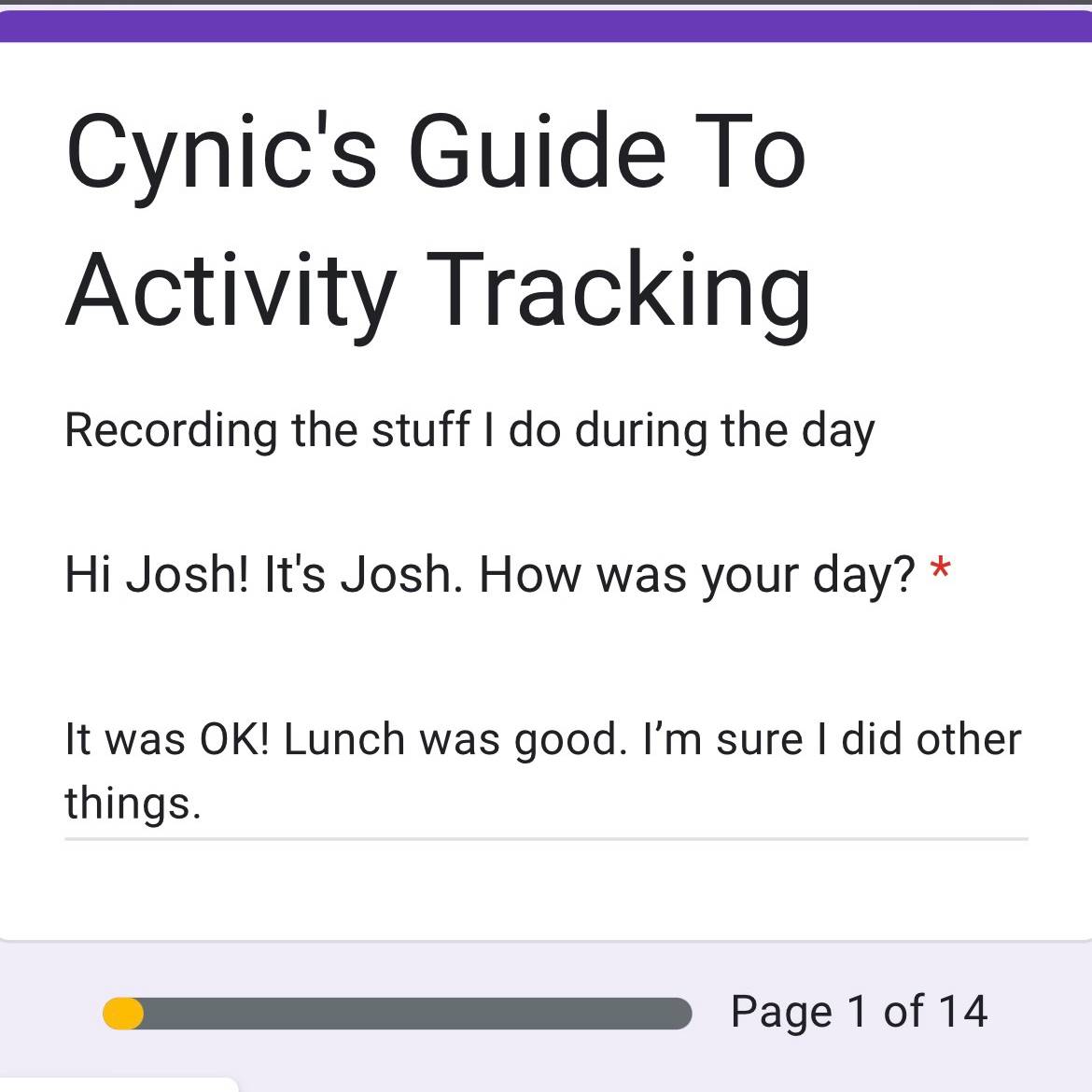
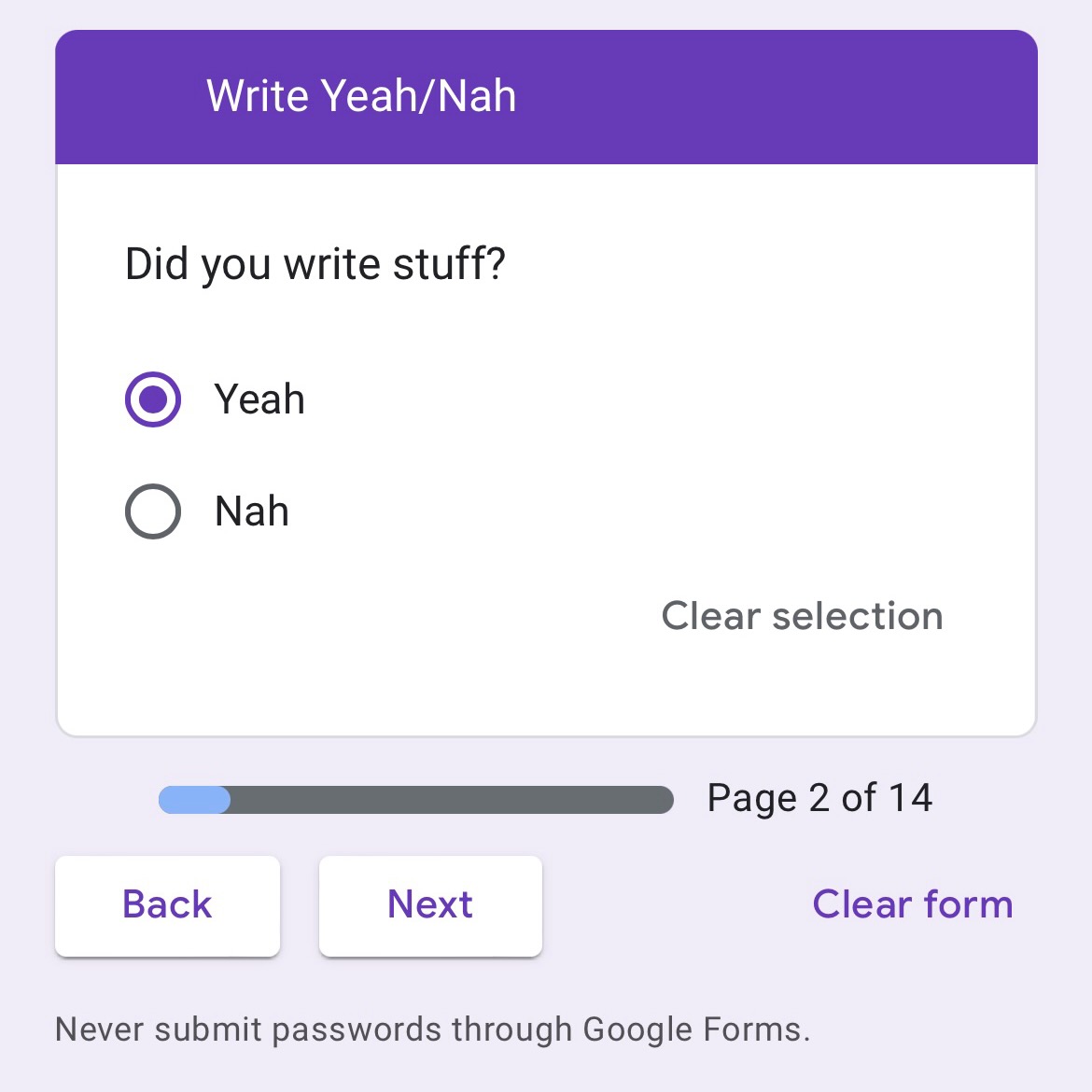

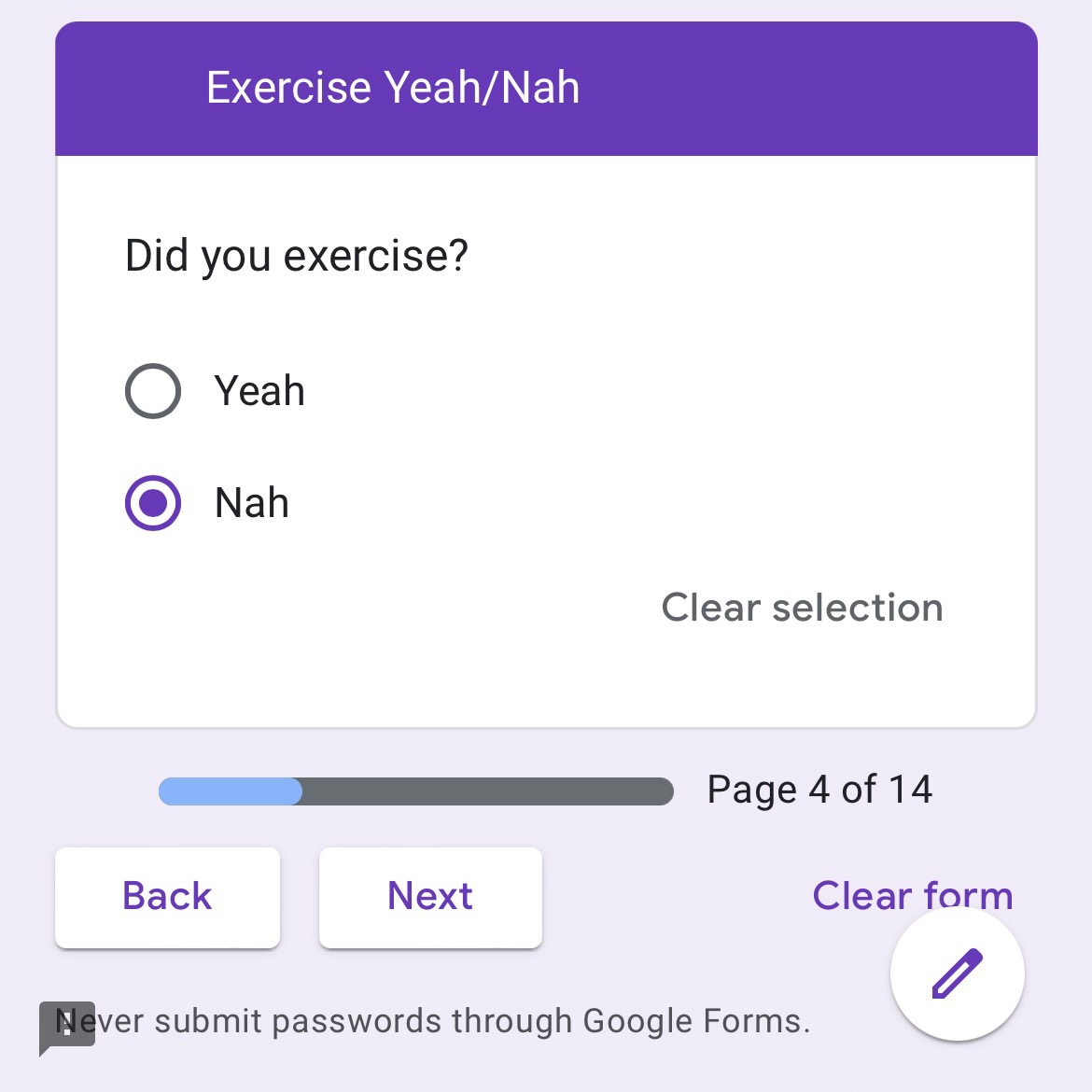
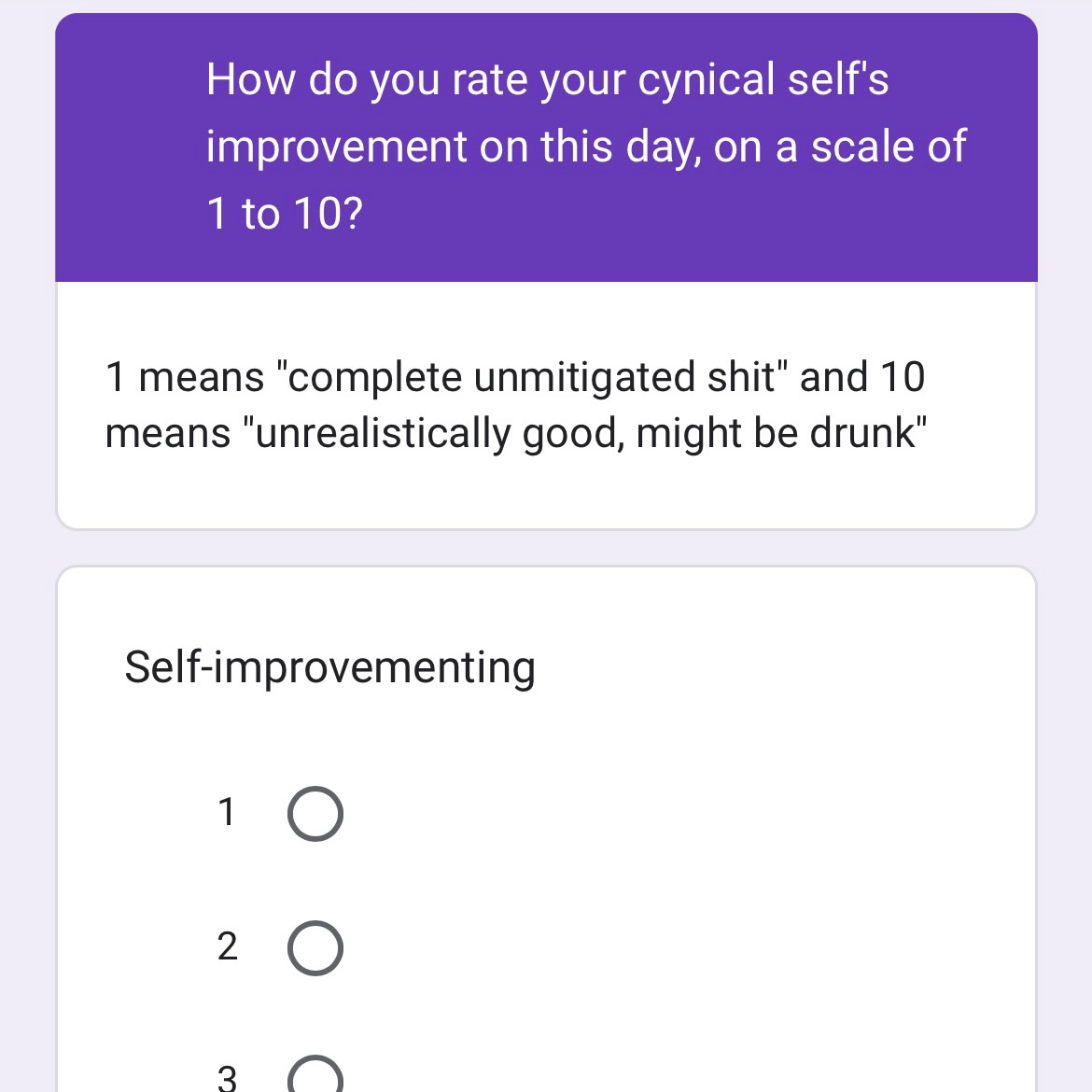
I’m pretty proud of the result. It’s free, it works, and over the last two and a half weeks I’ve filled out the form nearly every day. As a result, I’m getting a good idea of what I’m actually getting done, summarized in a set of handy graphs. Because I’m serious about being transparent with this exercise, you can see the results in exciting spreadsheet form, if you’re so inclined.
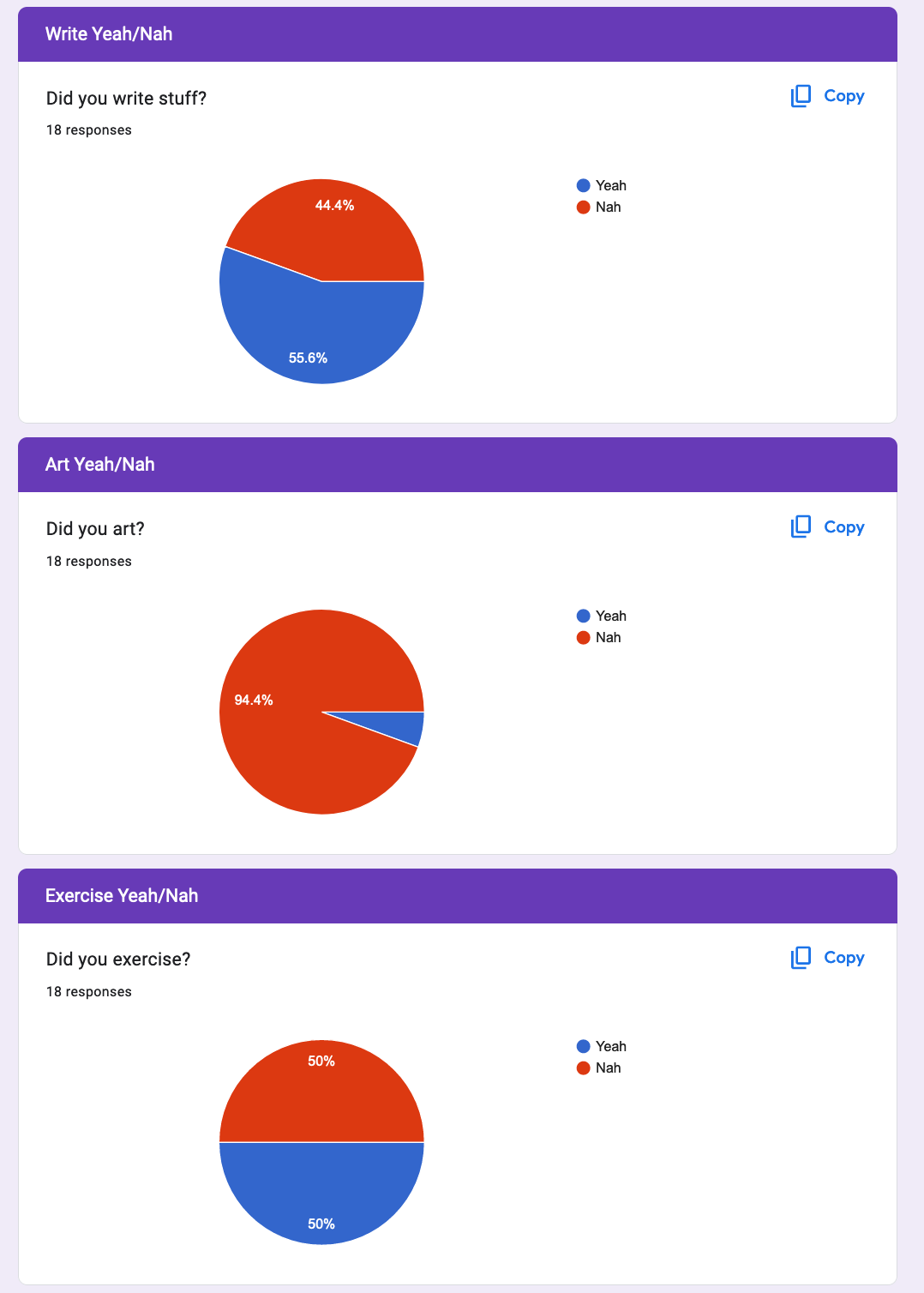
Hmm. Art is really languishing. Best get that pie graph looking a bit less like Pac-Man. If my boy gets a good night’s sleep tonight, I might even manage some tomorrow.
So that’s it for this week. As always, let me know what you think in the comments — I love reading your feedback. Seen any good examples of fakelore lately? Or some inspirational aphorisms that aren’t fakelore? Or do you have a useful habit-tracking system you’d like to talk about? Whatever it is, I’m keen to know about it. Do the thing.
As always, this newsletter is free. All I ask for payment is that you please share it around on your favourite social media time-sinks if you think anything in it was helpful or interesting.
Thank you for reading The Cynic's Guide To Self-Improvement. This post is public so feel free to share it.
Thanks for reading,
Josh





